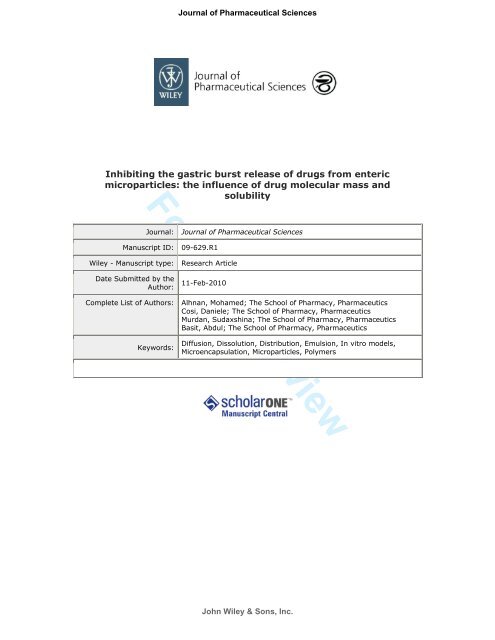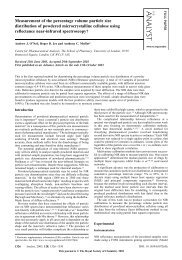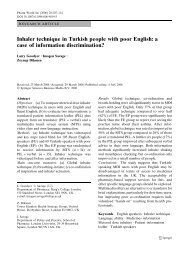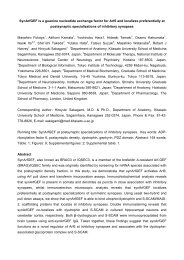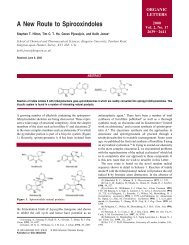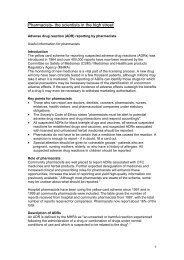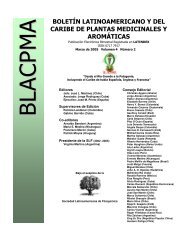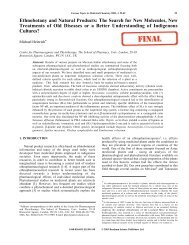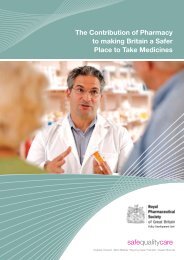For Peer Review - Pharmacy Eprints
For Peer Review - Pharmacy Eprints
For Peer Review - Pharmacy Eprints
You also want an ePaper? Increase the reach of your titles
YUMPU automatically turns print PDFs into web optimized ePapers that Google loves.
Inhibiting the gastric burst release of drugs from enteric<br />
microparticles: the influence of drug molecular mass and<br />
solubility<br />
<strong>For</strong> <strong>Peer</strong> <strong>Review</strong><br />
Journal: Journal of Pharmaceutical Sciences<br />
Manuscript ID: 09-629.R1<br />
Wiley - Manuscript type: Research Article<br />
Date Submitted by the<br />
Author: 11-Feb-2010<br />
Complete List of Authors: Alhnan, Mohamed; The School of <strong>Pharmacy</strong>, Pharmaceutics<br />
Cosi, Daniele; The School of <strong>Pharmacy</strong>, Pharmaceutics<br />
Murdan, Sudaxshina; The School of <strong>Pharmacy</strong>, Pharmaceutics<br />
Basit, Abdul; The School of <strong>Pharmacy</strong>, Pharmaceutics<br />
Keywords:<br />
Journal of Pharmaceutical Sciences<br />
Diffusion, Dissolution, Distribution, Emulsion, In vitro models,<br />
Microencapsulation, Microparticles, Polymers<br />
John Wiley & Sons, Inc.
Page 1 of 25<br />
1<br />
2<br />
3<br />
4<br />
5<br />
6<br />
7<br />
8<br />
9<br />
10<br />
11<br />
12<br />
13<br />
14<br />
15<br />
16<br />
17<br />
18<br />
19<br />
20<br />
21<br />
22<br />
23<br />
24<br />
25<br />
26<br />
27<br />
28<br />
29<br />
30<br />
31<br />
32<br />
33<br />
34<br />
35<br />
36<br />
37<br />
38<br />
39<br />
40<br />
41<br />
42<br />
43<br />
44<br />
45<br />
46<br />
47<br />
48<br />
49<br />
50<br />
51<br />
52<br />
53<br />
54<br />
55<br />
56<br />
57<br />
58<br />
59<br />
60<br />
Inhibiting the gastric burst release of drugs from enteric microparticles: the influence of<br />
drug molecular mass and solubility<br />
Mohamed A. Alhnan, Daniele Cosi, Sudaxshina Murdan and Abdul W. Basit *<br />
Department of Pharmaceutics, The School of <strong>Pharmacy</strong>, University of London,<br />
29/39 Brunswick Square, London WC1N 1AX<br />
Tel.: +44 20 7753 5865<br />
Fax: +44 20 7753 5865<br />
<strong>For</strong> <strong>Peer</strong> <strong>Review</strong><br />
E-mail Address: abdul.basit@pharmacy.ac.uk<br />
* Corresponding author<br />
Journal of Pharmaceutical Sciences<br />
1<br />
John Wiley & Sons, Inc.
1<br />
2<br />
3<br />
4<br />
5<br />
6<br />
7<br />
8<br />
9<br />
10<br />
11<br />
12<br />
13<br />
14<br />
15<br />
16<br />
17<br />
18<br />
19<br />
20<br />
21<br />
22<br />
23<br />
24<br />
25<br />
26<br />
27<br />
28<br />
29<br />
30<br />
31<br />
32<br />
33<br />
34<br />
35<br />
36<br />
37<br />
38<br />
39<br />
40<br />
41<br />
42<br />
43<br />
44<br />
45<br />
46<br />
47<br />
48<br />
49<br />
50<br />
51<br />
52<br />
53<br />
54<br />
55<br />
56<br />
57<br />
58<br />
59<br />
60<br />
Abstract<br />
Undesired drug release in acid medium from enteric microparticles has been widely<br />
reported. In this paper we investigate the relative contribution of microparticle and drug<br />
properties, specifically microsphere size and drug’s molecular weight and acid solubility,<br />
on the extent of such undesired release. A series of nine drugs with different<br />
physicochemical properties were successfully encapsulated into Eudragit S and Eudragit L<br />
microparticles using a novel emulsion solvent evaporation process. The process yielded<br />
spherical microparticles with a narrow size distribution (25-60 µm and 35-55 µm for<br />
<strong>For</strong> <strong>Peer</strong> <strong>Review</strong><br />
Eudragit L and Eudragit S microparticles respectively). Upon incubation in acid medium<br />
(pH 1.2) for 2 h, the release of dipyridamole, cinnarizine, amprenavir, bendroflumethiazide,<br />
budenoside, prednisolone from both Eudragit microparticles was less than 10% of drug<br />
load and conformed with USP specification for enteric dosage forms. In contrast, more than<br />
10% of the entrapped paracetamol, salicylic acid and ketoprofen were released. Multiple<br />
regression revealed that the drug’s molecular weight was the most important factor that<br />
determined its extent of release in the acid medium, while its acid solubility and<br />
microsphere’s size had minor influences.<br />
Keywords: Microspheres, delayed release, enteric polymers, methacrylic polymers, gastric<br />
resistance, colonic delivery.<br />
Journal of Pharmaceutical Sciences<br />
2<br />
John Wiley & Sons, Inc.<br />
Page 2 of 25
Page 3 of 25<br />
1<br />
2<br />
3<br />
4<br />
5<br />
6<br />
7<br />
8<br />
9<br />
10<br />
11<br />
12<br />
13<br />
14<br />
15<br />
16<br />
17<br />
18<br />
19<br />
20<br />
21<br />
22<br />
23<br />
24<br />
25<br />
26<br />
27<br />
28<br />
29<br />
30<br />
31<br />
32<br />
33<br />
34<br />
35<br />
36<br />
37<br />
38<br />
39<br />
40<br />
41<br />
42<br />
43<br />
44<br />
45<br />
46<br />
47<br />
48<br />
49<br />
50<br />
51<br />
52<br />
53<br />
54<br />
55<br />
56<br />
57<br />
58<br />
59<br />
60<br />
INTRODUCTION<br />
Journal of Pharmaceutical Sciences<br />
The last two decades witnessed the emergence of microencapsulation technology in<br />
pharmaceutical formulations 1,2 , which provided a unique platform for delayed and site-<br />
specific oral drug delivery 3 . Modified release microparticles provide several advantages<br />
over conventional enteric and delayed release formulations such as larger surface area,<br />
potentially more uniform gastric emptying, and a more consistent drug release profile.<br />
Unfortunately, the particulate nature and large surface area are accompanied by a major<br />
challenge: the inhibition of drug release until the target site is reached. In in vitro<br />
dissolution tests, enteric formulations may release no more than 10% of their drug content<br />
<strong>For</strong> <strong>Peer</strong> <strong>Review</strong><br />
during a two-hour incubation in 0.1N HCl, and subsequently should release more than 80%<br />
of their drug content within 45 min of changing the dissolution medium to intestinal<br />
conditions. While drug release in intestinal conditions is easily achieved given that readily<br />
suspended microparticles have a large surface area, minimising/inhibiting drug release in<br />
acidic conditions has proven challenging, and insufficient control of drug release from<br />
microparticles in acid media has been reported 4-10 .<br />
It is commonly assumed that the microparticles’ surface area is the major factor influencing<br />
drug release from matrix microparticles 11,12 . This is in contrast to a previous report by our<br />
group which showed that reducing the size of Eudragit S microparticles by two thirds did<br />
not alter prednisolone release in the acidic medium 13 . Very little attention has been given to<br />
the chemical properties of the drug molecule itself. Silva and Ferreira 7 used an empirical<br />
approach to explore the major factors affecting drug release from microparticles and<br />
suggested that high molecular weight and poor drug solubility in acid favours low drug<br />
release in acid medium. We have shown that the control of drug release was not necessarily<br />
influenced by drug distribution within the microparticle or by high drug solubility in acid 14 .<br />
Nevertheless, the relative importance of all these factors is still unclear.<br />
The aim of the work described in this paper was therefore to explore the relative<br />
importance of three drug and particle properties that have been directly related to drug<br />
release in gastric conditions 6,7,15 , namely, drug molecular weight and its solubility in acid,<br />
and microsphere size. Using an efficient o/o emulsion solvent evaporation method<br />
developed in our laboratory 13,16 , small uniform-size microparticles loaded with one of nine<br />
drug molecules of different physicochemical properties were produced using two different<br />
3<br />
John Wiley & Sons, Inc.
1<br />
2<br />
3<br />
4<br />
5<br />
6<br />
7<br />
8<br />
9<br />
10<br />
11<br />
12<br />
13<br />
14<br />
15<br />
16<br />
17<br />
18<br />
19<br />
20<br />
21<br />
22<br />
23<br />
24<br />
25<br />
26<br />
27<br />
28<br />
29<br />
30<br />
31<br />
32<br />
33<br />
34<br />
35<br />
36<br />
37<br />
38<br />
39<br />
40<br />
41<br />
42<br />
43<br />
44<br />
45<br />
46<br />
47<br />
48<br />
49<br />
50<br />
51<br />
52<br />
53<br />
54<br />
55<br />
56<br />
57<br />
58<br />
59<br />
60<br />
pH responsive polymers; Eudragit S and Eudragit L (pH thresholds 7.0 and 6.0<br />
respectively). In addition, multiple regression was used to investigate the relative<br />
importance of the 3 drug/microsphere properties and to explore the limitations of pH<br />
responsive matrix microparticles.<br />
MATERIALS AND METHODS<br />
Materials<br />
Paracetamol was supplied by Knoll AG (Ludwigshafen, Germany) and prednisolone was<br />
<strong>For</strong> <strong>Peer</strong> <strong>Review</strong><br />
obtained from Sanofi-Aventis, (Romainville, France). Budenoside and amprenavir were<br />
gifts from Astra Zeneca (UK) and GlaxoSmithKline (UK) respectively. Ketoprofen,<br />
salicylic acid, dipyridamole, cinnarizine, bendroflumethiazide, sorbitan sesquioleate (Span<br />
83, Arlacel 83) and liquid paraffin were purchased from Sigma-Aldrich, (Poole, UK).<br />
Polymethacrylate polymers, Eudragit S and L, were generously provided by Evonik<br />
Degussa Chemicals (Darmstadt, Germany).<br />
Preparation of microparticles<br />
Drug loaded Eudragit S or Eudragit L microparticles were prepared as reported<br />
previously 16 . Briefly, 0.3 g of drug (indomethacin, paracetamol, salicylic acid, ketoprofen,<br />
naproxen, prednisolone, budenoside, bendroflumethiazide, amprenavir or dipyridamole)<br />
and 3 g of polymer (Eudragit S /L) were dissolved in 30 ml of absolute ethanol. The<br />
resulting solution was emulsified into 200 ml liquid paraffin containing sorbitan<br />
sesquioleate (Span 83) (1% w/w) as the emulsifier by stirring at a speed of 1000 rpm<br />
(Heidolph RZR1 stirrer, Heidolph Instruments, Schwabach, Germany) for 18 hours at room<br />
temperature. Solidified microparticles were collected by vacuum filtration, followed by<br />
washing three times using fresh batches of 50 ml n-hexane. Due to cinnarizine’s low<br />
solubility in ethanol, the drug and the polymer (Eudragit S or Eudragit L) were dissolved in<br />
30 ml of a mixture of ethanol: acetone (1:1 v/v) and microparticles were prepared as above.<br />
Microspheres size analysis<br />
Journal of Pharmaceutical Sciences<br />
The volume median diameter of each microparticle formulation suspended in 0.1N HCl<br />
was measured in triplicate using laser light scattering using a Malvern Mastersizer 2000<br />
with a 45mm lens (Malvern Instruments Ltd., Malvern, UK). Span of microsphere size was<br />
calculated as [D(v,0.9)−D(v, 0.1)] /D(v,0.5) where D(v,0.9), D(v,0.5) and D(v,0.1) are the<br />
4<br />
John Wiley & Sons, Inc.<br />
Page 4 of 25
Page 5 of 25<br />
1<br />
2<br />
3<br />
4<br />
5<br />
6<br />
7<br />
8<br />
9<br />
10<br />
11<br />
12<br />
13<br />
14<br />
15<br />
16<br />
17<br />
18<br />
19<br />
20<br />
21<br />
22<br />
23<br />
24<br />
25<br />
26<br />
27<br />
28<br />
29<br />
30<br />
31<br />
32<br />
33<br />
34<br />
35<br />
36<br />
37<br />
38<br />
39<br />
40<br />
41<br />
42<br />
43<br />
44<br />
45<br />
46<br />
47<br />
48<br />
49<br />
50<br />
51<br />
52<br />
53<br />
54<br />
55<br />
56<br />
57<br />
58<br />
59<br />
60<br />
particle diameters at the 90th, 50th and 10th percentile respectively of the microsphere size<br />
distribution curve. Microsphere size analysis of each formulation was carried out in<br />
triplicate.<br />
X-Ray Powder Diffraction<br />
A Philips PW3710 Scanning X-Ray Diffractometer (Philips, Cambridge, UK) with a Cu Kα<br />
filter generated at 30mA and 45 kV was used to characterize the drug loaded<br />
microparticles. Samples were placed in a round disc sample holder and gently compressed<br />
and smoothed using Perspex block. Samples were scanned at 0.02 º/sec from 5º to 45º. The<br />
<strong>For</strong> <strong>Peer</strong> <strong>Review</strong><br />
peak was calculated using X’Pert HighScore data analysis software (version 2.0a).<br />
Differential Scanning Calorimetry<br />
A DSC 7 Differential Scanning Calorimeter (PerkinElmer Instruments, Beaconsfields, UK)<br />
calibrated with indium, was used to assess the presence of crystalline drug in Eudragit S<br />
and Eudragit L microparticles. Microparticles (3-5 mg) were accurately weighed and<br />
placed in non-hermetic aluminum pan. Before starting the thermo scan, an isothermal<br />
period at 100 ºC (90˚C for ketoprofen microparticles) was applied for 5 min (to eliminate<br />
residual water content), then the samples were cooled and scanned from 50 ºC to 200 ºC at<br />
a rate of 10 ºC/min. Pyris Thermal Analysis Software was used to record and analyze the<br />
data.<br />
Journal of Pharmaceutical Sciences<br />
Drug encapsulation efficiency in microparticles<br />
Drug loaded microparticles (50 mg) were dissolved in 50ml methanol. The resulting<br />
solution was then diluted 10 times with HCl 0.1 N (for neutral and basic drugs) or with<br />
phosphate buffer pH 7.4 (for acidic drugs). Samples were filtered using a 0.22µm Millex<br />
filter and assayed spectrophotometrically. UV-Vis absorbance was measured using<br />
spectrophotometer at λmax = 243, 301, 254, 245, 246, 254, 263, and 280 nm for<br />
paracetamol, salicylic acid, ketoprofen, prednisolone, budenoside, bendroflumethiazide,<br />
amprenavir, and dipyridamole respectively. The encapsulation efficiency of cinnarizine was<br />
determined by dissolving 50 mg of microparticles in 50 ml methanol; 10 ml was taken and<br />
0.1M HCl was added to precipitate the polymers and made up to 100 ml. Samples were<br />
filtered through 0.22 µm Millex filters and 3.75 ml of the filtrate was added to 5 ml of<br />
acetonitrile followed by the addition of 1.25 ml of triphosphate buffer. Cinnarizine was<br />
assayed using Hypersil column Thermo Scientific (Runcorn, UK). A Hewlett-Packard 1050<br />
5<br />
John Wiley & Sons, Inc.
1<br />
2<br />
3<br />
4<br />
5<br />
6<br />
7<br />
8<br />
9<br />
10<br />
11<br />
12<br />
13<br />
14<br />
15<br />
16<br />
17<br />
18<br />
19<br />
20<br />
21<br />
22<br />
23<br />
24<br />
25<br />
26<br />
27<br />
28<br />
29<br />
30<br />
31<br />
32<br />
33<br />
34<br />
35<br />
36<br />
37<br />
38<br />
39<br />
40<br />
41<br />
42<br />
43<br />
44<br />
45<br />
46<br />
47<br />
48<br />
49<br />
50<br />
51<br />
52<br />
53<br />
54<br />
55<br />
56<br />
57<br />
58<br />
59<br />
60<br />
series HPLC system (Agilent Technologies, UK) supplied with Waters 470 Millipore<br />
fluorescence detector (Milford, MA, USA) was utilized to detect samples. The mobile<br />
phase, consisting of acetonitrile (70% v/v) and 10 mM potassium dihydrogen phosphate<br />
buffer (30% v/v), was eluted at a flow rate of 1 ml/min. The injection volume was 10 µl,<br />
and the fluorescence detector employed an excitation wavelength of 249 nm and emission<br />
wavelength of 311 nm.<br />
<strong>For</strong> each formulation, 3 different batches were assessed. Drug encapsulation efficiency was<br />
calculated as:<br />
measured mass of drug in microparticles<br />
encapsulat ion efficiency =<br />
× 100<br />
theoretical<br />
mass of drug in microparticles<br />
Eq.1<br />
Drug solubility in acidic medium<br />
<strong>For</strong> <strong>Peer</strong> <strong>Review</strong><br />
In order to assess the influence of the drug’s solubility in acid on its release, the solubility<br />
of all encapsulated drugs in acidic medium were assayed. An excess amount of drug was<br />
added to 10 ml of HCl 0.1 N solution and shaken for 24 hours at 200 rpm and 37 °C. The<br />
saturated solutions were filtered (0.22 µm Milleux syringe filters), diluted as appropriate,<br />
and UV absorbance was measured at λmax as detailed in encapsulation efficiency section.<br />
Drug solubility was calculated from Beer-Lambert plots. In case of cinnarizine, drug<br />
concentration was assessed in saturated solution according to the HPLC method reported in<br />
the previous section.<br />
In vitro drug release from microparticles<br />
Journal of Pharmaceutical Sciences<br />
The USP II paddle apparatus (Model PTWS, Pharmatest, Hainburg, Germany) equipped<br />
with inline analysis coupled with 0.22 µm filter was employed to assess the microparticles’<br />
dissolution profiles. Microparticles (0.1g) were accurately weighed and filled into capsule<br />
size 0. Each capsule was placed in a metal sinker to ensure a submerged position in a vessel<br />
containing 750 mL of 0.1N HCl as dissolution medium at 37 ± 0.5 °C. After 120 min, 250<br />
mL of 0.2M tri-sodium phosphate (equilibrated to 37 ± 0.5 °C) was added to the dissolution<br />
vessel, and the pH of the solution was adjusted to 7.4±0.05 if necessary using 5N HCl or<br />
4N NaOH solutions, and the dissolution experiment was continued for another 4 hours.<br />
Samples were taken every 5 min, the speed of the paddle was 100 rpm and each dissolution<br />
test was replicated 3 times. Data were processed using Icalis software (Icalis Data Systems<br />
Ltd, Berkshire, UK). A standard calibration curve was prepared for each drug in acidic and<br />
6<br />
John Wiley & Sons, Inc.<br />
Page 6 of 25
Page 7 of 25<br />
1<br />
2<br />
3<br />
4<br />
5<br />
6<br />
7<br />
8<br />
9<br />
10<br />
11<br />
12<br />
13<br />
14<br />
15<br />
16<br />
17<br />
18<br />
19<br />
20<br />
21<br />
22<br />
23<br />
24<br />
25<br />
26<br />
27<br />
28<br />
29<br />
30<br />
31<br />
32<br />
33<br />
34<br />
35<br />
36<br />
37<br />
38<br />
39<br />
40<br />
41<br />
42<br />
43<br />
44<br />
45<br />
46<br />
47<br />
48<br />
49<br />
50<br />
51<br />
52<br />
53<br />
54<br />
55<br />
56<br />
57<br />
58<br />
59<br />
60<br />
buffer media. The absorbance of blank microparticles following the same dissolution<br />
procedure was measured and subtracted from those of the drug loaded microparticles to<br />
remove any interference from the Eudragit polymer and gelatin capsules. In case of<br />
cinnarizine, HPLC method reported above was applied to medium solutions.<br />
Multiple Regression<br />
Standard multiple regression using SPSS statistics software 17.0.0 (SPSS Inc., Chicago,<br />
U.S.) was conducted to assess the feasibility of predicting the control of drug release from<br />
microparticles in acidic medium from the following variables: drug molecular weight and<br />
<strong>For</strong> <strong>Peer</strong> <strong>Review</strong><br />
its solubility in acid and microparticle diameter. The highly spherical morphology of the<br />
microparticles and the narrow size distribution of the majority of the prepared particles<br />
allowed the use of the square of diameter as representative of particles surface area. No<br />
violation of the assumptions of normality, linearity, multicolinearity and homoscedasticity<br />
was found.<br />
RESULTS AND DISCUSSION<br />
Microsphere properties<br />
All nine drugs were successfully encapsulated into Eudragit L and Eudragit S<br />
microparticles. The particles were spherical and had a uniform size distribution of 25-60<br />
µm and 35-55 µm for Eudragit L and Eudragit S respectively (Table 1). Representative<br />
SEM images of amprenavir and prednisolone loaded microparticles are shown in Fig.1.<br />
According to the SEM images, there was no evidence of porosity in any of the fabricated<br />
microparticles. In addition, X-ray powder diffraction and thermal analysis showed no<br />
evidence of crystallinity in the microparticles.<br />
Journal of Pharmaceutical Sciences<br />
Eudragit S microparticles were significantly larger than Eudragit L ones (paired samples t-<br />
test, t(11)=3.39, p
1<br />
2<br />
3<br />
4<br />
5<br />
6<br />
7<br />
8<br />
9<br />
10<br />
11<br />
12<br />
13<br />
14<br />
15<br />
16<br />
17<br />
18<br />
19<br />
20<br />
21<br />
22<br />
23<br />
24<br />
25<br />
26<br />
27<br />
28<br />
29<br />
30<br />
31<br />
32<br />
33<br />
34<br />
35<br />
36<br />
37<br />
38<br />
39<br />
40<br />
41<br />
42<br />
43<br />
44<br />
45<br />
46<br />
47<br />
48<br />
49<br />
50<br />
51<br />
52<br />
53<br />
54<br />
55<br />
56<br />
57<br />
58<br />
59<br />
60<br />
efficiencies than Eudragit L microparticles (paired samples t-test, t(11)=5.76, p10% of drug content).<br />
Upon changing the pH to 6.8 and 7.4 for Eudragit L and Eudragit S microparticles<br />
respectively, rapid and complete drug release was achieved within 20 min and 45 min for<br />
Eudragit L and Eudragit S respectively for all drugs except for cinnarizine (Figs. 2 and 3).<br />
The slower release from Eudragit S microparticles could be due to its larger size (and hence<br />
smaller surface area), as well as a slower dissolution of the Eudragit S polymer. A lower<br />
dissolution rate of Eudragit S films (compared to Eudragit L ones) has been reported 17 . The<br />
limited release of cinnarizine at high pH is attributed to the poor solubility of the basic drug<br />
in phosphate buffer. It was noted that drug crystals appeared in the dissolution medium<br />
after pH change, indicating a rapid precipitation of cinnarizine.<br />
Influence of drug and particle properties on the control of drug release in acid<br />
medium<br />
Journal of Pharmaceutical Sciences<br />
Plots of drug release versus: i) drug molecular weight, ii) solubility in acidic medium and<br />
iii) microsphere size are shown in Figs. 4-6. No clear relationship was found between the<br />
solubility of the drug in acid medium or microsphere size and drug release in the acidic<br />
medium. In contrast, the drug’s molecular weight seemed to have a significant impact on its<br />
release, drug release decreasing exponentially with increasing molecular weight. A<br />
minimum molecular weight of around 300 Da seems to be necessary for control of drug<br />
release in acid medium (Fig. 6). A larger molecular size of the drug is likely to impede its<br />
movement through the polymeric network of the microparticle matrix and hence its release<br />
in acid medium 7 . The relative importance of the two drug properties, molecular weight and<br />
8<br />
John Wiley & Sons, Inc.<br />
Page 8 of 25
Page 9 of 25<br />
1<br />
2<br />
3<br />
4<br />
5<br />
6<br />
7<br />
8<br />
9<br />
10<br />
11<br />
12<br />
13<br />
14<br />
15<br />
16<br />
17<br />
18<br />
19<br />
20<br />
21<br />
22<br />
23<br />
24<br />
25<br />
26<br />
27<br />
28<br />
29<br />
30<br />
31<br />
32<br />
33<br />
34<br />
35<br />
36<br />
37<br />
38<br />
39<br />
40<br />
41<br />
42<br />
43<br />
44<br />
45<br />
46<br />
47<br />
48<br />
49<br />
50<br />
51<br />
52<br />
53<br />
54<br />
55<br />
56<br />
57<br />
58<br />
59<br />
60<br />
drug acid solubility, can be visualised in Figs. 7a-b. The figures clearly illustrate that<br />
release of larger drug molecules (>300 Da) are likely to be well-controlled and fulfil the<br />
USP criteria for delayed release formulations regardless of the drug’s solubility in the<br />
medium.<br />
To quantify the different influences, multi-linear regression was conducted, and yielded the<br />
following equation:<br />
Drug Released (%) =<br />
Eq.5<br />
<strong>For</strong> <strong>Peer</strong> <strong>Review</strong><br />
55.123-0.123 MW+9.7 Log (Sol) -0.012 d 2 + 1.55 P<br />
where MW = drug molecular weight (Da), Log(Sol) = logarithm of drug saturation<br />
solubility in the acidic medium at 37 °C assessed in mg/L, d = Median diameter of<br />
microparticles (µm) and P is a constant relating to the polymer, P = 0 for Eudragit S and P<br />
= 1 for Eudragit L.<br />
It can be seen that drug release was increased by higher drug solubility and reduced by<br />
higher drug molecular weight and larger microparticle size. The multiple regression<br />
standardized coefficients revealed that molecular weight was by far the most prominent<br />
factor in controlling drug release (Standardized coefficient Beta = -0.617, p
1<br />
2<br />
3<br />
4<br />
5<br />
6<br />
7<br />
8<br />
9<br />
10<br />
11<br />
12<br />
13<br />
14<br />
15<br />
16<br />
17<br />
18<br />
19<br />
20<br />
21<br />
22<br />
23<br />
24<br />
25<br />
26<br />
27<br />
28<br />
29<br />
30<br />
31<br />
32<br />
33<br />
34<br />
35<br />
36<br />
37<br />
38<br />
39<br />
40<br />
41<br />
42<br />
43<br />
44<br />
45<br />
46<br />
47<br />
48<br />
49<br />
50<br />
51<br />
52<br />
53<br />
54<br />
55<br />
56<br />
57<br />
58<br />
59<br />
60<br />
Journal of Pharmaceutical Sciences<br />
formulations. The particles had the desirable properties of spherical morphology, smooth<br />
surface, small microsphere size (
Page 11 of 25<br />
1<br />
2<br />
3<br />
4<br />
5<br />
6<br />
7<br />
8<br />
9<br />
10<br />
11<br />
12<br />
13<br />
14<br />
15<br />
16<br />
17<br />
18<br />
19<br />
20<br />
21<br />
22<br />
23<br />
24<br />
25<br />
26<br />
27<br />
28<br />
29<br />
30<br />
31<br />
32<br />
33<br />
34<br />
35<br />
36<br />
37<br />
38<br />
39<br />
40<br />
41<br />
42<br />
43<br />
44<br />
45<br />
46<br />
47<br />
48<br />
49<br />
50<br />
51<br />
52<br />
53<br />
54<br />
55<br />
56<br />
57<br />
58<br />
59<br />
60<br />
Journal of Pharmaceutical Sciences<br />
Reference List<br />
1. Kawashima Y, Niwa T, Handa T, Takeuchi H, Iwamoto T, Itoh Y 1989. Preparation<br />
of prolonged-release spherical micro-matrix of ibuprofen with acrylic polymer by<br />
the emulsion-solvent diffusion method for improving bioavailability. Chem Pharm<br />
Bull (Tokyo) 37:425-429.<br />
2. Huang HP, Ghebre-Sellassie I 1989. Preparation of microspheres of water-soluble<br />
pharmaceuticals. J Microencapsul 6:219-225.<br />
3. Watts PJ, Davies MC, Melia CD 1990. Microencapsulation using<br />
emulsification/solvent evaporation: an overview of techniques and applications. Crit<br />
Rev Ther Drug Carrier Syst 7:235-259.<br />
<strong>For</strong> <strong>Peer</strong> <strong>Review</strong><br />
4. Kilicarslan M, Baykara T 2004. Effects of the permeability characteristics of<br />
different polymethacrylates on the pharmaceutical characteristics of verapamil<br />
hyhdrochloride-loaded microspheres. J Microencapsul 21:175-189.<br />
5. Obeidat WM, Price JC 2005. Preparation and in vitro evaluation of propylthiouracil<br />
microspheres made of Eudragit RL 100 and cellulose acetate butyrate polymers<br />
using the emulsion-solvent evaporation method. J Microencapsul 22:281-289.<br />
6. Obeidat WM, Price JC 2006. Preparation and evaluation of Eudragit S 100<br />
microspheres as pH-sensitive release preparations for piroxicam and theophylline<br />
using the emulsion-solvent evaporation method. J Microencapsul 23:195-202.<br />
7. Silva JP FJP 1999. Effect of drug properties on the release from CAP microspheres<br />
prepared by a solvent evaporation method. J Microencapsul 16:95-103.<br />
8. Esposito E, Cervellati F, Menegatti E, Nastruzzi C, Cortesi R 2002. Spray dried<br />
Eudragit microparticles as encapsulation devices for vitamin C. Int J Pharm<br />
242:329-334.<br />
9. Raffin RP, Colome LM, Pohlmann AR, Guterres SS 2006. Preparation,<br />
characterization, and in vivo anti-ulcer evaluation of pantoprazole-loaded<br />
microparticles. Eur J Pharm Biopharm 63:198-204.<br />
10. Raffin RP, Jornada DS, Re MI, Pohlmann AR, Guterres SS 2006. Sodium<br />
pantoprazole-loaded enteric microparticles prepared by spray drying: Effect of the<br />
scale of production and process validation. Int J Pharm 324:10-18.<br />
11. Obeidat WM, Price JC 2006. Preparation and evaluation of Eudragit S 100<br />
microspheres as pH-sensitive release preparations for piroxicam and theophylline<br />
using the emulsion-solvent evaporation method. J Microencapsul 23:195-202.<br />
12. Song M, Li N, Sun S, Tiedt LR, Liebenberg W, de Villiers MM 2005. Effect of<br />
Viscosity and Concentration of Wall <strong>For</strong>mer, Emulsifier and Pore-Inducer on the<br />
Properties of Amoxicillin Microcapsules Prepared by Emulsion Solvent<br />
Evaporation. Il Farmaco 60:261-267.<br />
11<br />
John Wiley & Sons, Inc.
1<br />
2<br />
3<br />
4<br />
5<br />
6<br />
7<br />
8<br />
9<br />
10<br />
11<br />
12<br />
13<br />
14<br />
15<br />
16<br />
17<br />
18<br />
19<br />
20<br />
21<br />
22<br />
23<br />
24<br />
25<br />
26<br />
27<br />
28<br />
29<br />
30<br />
31<br />
32<br />
33<br />
34<br />
35<br />
36<br />
37<br />
38<br />
39<br />
40<br />
41<br />
42<br />
43<br />
44<br />
45<br />
46<br />
47<br />
48<br />
49<br />
50<br />
51<br />
52<br />
53<br />
54<br />
55<br />
56<br />
57<br />
58<br />
59<br />
60<br />
13. Nilkumhang S, Basit AW 2009. The robustness and flexibility of an emulsion<br />
solvent evaporation method to prepare pH-responsive microparticles. Int J Pharm in<br />
press.<br />
14. Nilkumhang S, Alhnan MA, McConnell E, Basit AW 2009. Drug distribution in<br />
enteric microparticles. Int J Pharm In press.<br />
15. Song M, Li N, Sun S, Tiedt LR, Liebenberg W, de Villiers MM 2005. Effect of<br />
viscosity and concentration of wall former, emulsifier and pore-inducer on the<br />
properties of amoxicillin microcapsules prepared by emulsion solvent evaporation.<br />
Farmaco 60:261-267.<br />
16. Kendall R, Alhnan MA, Nilkumhang S, Murdan S, Basit AW 2009. Fabrication and<br />
in vivo evaluation of highly pH-responsive acrylic microparticles for targeted<br />
gastrointestinal delivery. Eur J Pharm Sci 37:284-290.<br />
<strong>For</strong> <strong>Peer</strong> <strong>Review</strong><br />
17. Lehmann K, Petereit H, Dreher D 1993. Fast disintegrating controlled-release<br />
tablets from coated particles. Pharm Ind 55:940-947.<br />
18. Hsiue GH, Liao CM, Lin SY 1998. Effect of drug-polymer interaction on the<br />
release characteristics of methacrylic acid copolymer microcapsules containing<br />
theophylline. Artif Organs 22:651-656.<br />
19. Jenquin MR, Liebowitz SM, Sarabia RE, McGinity JW 1990. Physical and<br />
chemical factors influencing the release of drugs from acrylic resin films. J Pharm<br />
Sci 79:811-816.<br />
20. Karavas E, Ktistis G, Xenakis A, Georgarakis E 2006. Effect of hydrogen bonding<br />
interactions on the release mechanism of felodipine from nanodispersions with<br />
polyvinylpyrrolidone. Eur J Pharm Biopharm 63:103-114.<br />
21. Mortada LM, Bostanian LA, Salib NN 1990. Interactions of oxyphenbutazone with<br />
polyvinylpyrrolidone. Pharmazie 45.<br />
List of figures<br />
Fig. 1. SEM micrograph of amprenavir (1a and 1b), prednisolone (1c and 1d) loaded<br />
Eudragit S and Eudragit L microparticles<br />
Fig. 2. % drug release from Eudragit L microparticles with time, using a pH-change<br />
dissolution method.<br />
Fig. 3. % drug release from Eudragit S microparticles with time, using a pH-change<br />
dissolution method.<br />
Journal of Pharmaceutical Sciences<br />
12<br />
John Wiley & Sons, Inc.<br />
Page 12 of 25
Page 13 of 25<br />
1<br />
2<br />
3<br />
4<br />
5<br />
6<br />
7<br />
8<br />
9<br />
10<br />
11<br />
12<br />
13<br />
14<br />
15<br />
16<br />
17<br />
18<br />
19<br />
20<br />
21<br />
22<br />
23<br />
24<br />
25<br />
26<br />
27<br />
28<br />
29<br />
30<br />
31<br />
32<br />
33<br />
34<br />
35<br />
36<br />
37<br />
38<br />
39<br />
40<br />
41<br />
42<br />
43<br />
44<br />
45<br />
46<br />
47<br />
48<br />
49<br />
50<br />
51<br />
52<br />
53<br />
54<br />
55<br />
56<br />
57<br />
58<br />
59<br />
60<br />
Fig. 4. % drug release from microparticles as a function of drug acid solubility (the dotted<br />
line represents USP criteria)<br />
Fig. 5. % drug release from microparticles as a function of microsphere size (the dotted line<br />
represents USP criteria)<br />
Fig. 6. % drug release from microparticles as a function of drug molecular weight (the<br />
dotted line represents USP criteria)<br />
<strong>For</strong> <strong>Peer</strong> <strong>Review</strong><br />
Fig. 7. Relative importance of drug molecular weight and drug acid solubility on drug<br />
release from (a) Eudragit S and (b) Eudragit L microparticles after 2 hours in gastric<br />
medium (sphere size is proportional to drug molecular weight, the dotted line represents<br />
USP criteria).<br />
List of tables<br />
Journal of Pharmaceutical Sciences<br />
Table 1: Drug’s molecular weight and microsphere size, encapsulation efficiency and<br />
percentage drug release in acid medium from Eudragit S and Eudragit L microparticles.<br />
13<br />
John Wiley & Sons, Inc.
1<br />
2<br />
3<br />
4<br />
5<br />
6<br />
7<br />
8<br />
9<br />
10<br />
11<br />
12<br />
13<br />
14<br />
15<br />
16<br />
17<br />
18<br />
19<br />
20<br />
21<br />
22<br />
23<br />
24<br />
25<br />
26<br />
27<br />
28<br />
29<br />
30<br />
31<br />
32<br />
33<br />
34<br />
35<br />
36<br />
37<br />
38<br />
39<br />
40<br />
41<br />
42<br />
43<br />
44<br />
45<br />
46<br />
47<br />
48<br />
Table 1<br />
Drug<br />
Salicylic acid<br />
Paracetamol<br />
Ketoprofen<br />
Solubility<br />
in acidic<br />
medium<br />
(mg/L)<br />
Molecular<br />
weight<br />
1,435.5 138.1<br />
12,309 151.1<br />
75.6 254.2<br />
Prednisolone 218 360.4<br />
Cinnarizine<br />
Bendroflumethiazide<br />
Budenoside<br />
Dipyridamole<br />
Amprenavir<br />
2,110.6 369.5<br />
30.2 421.4<br />
20.0 430.5<br />
29,200 504.7<br />
89.0 505.6<br />
Journal of Pharmaceutical Sciences<br />
Particle size<br />
D(0,5)±SD µm (Span ±S.D)<br />
Encapsulation efficiency<br />
(%) ±SD<br />
<strong>For</strong> <strong>Peer</strong> <strong>Review</strong><br />
Drug release after 2hours<br />
(%)±SD<br />
(Da) Eudragit S Eudragit L Eudragit S Eudragit L Eudragit S Eudragit L<br />
46 ± 4.2 (3.0 ± 4.0) 31 ± 1.3 (0.7 ± 0.0) 107.2 ± 5.1 104 ± 1. 9 40.8 ± 0.5 86.9 ± 1.3<br />
38 ± 1.9 (0.8 ± 0.07) 30 ± 1.2 (1.2 ± 0.1) 83.5 ± 0.7 83 ± 1.0 57.3 ± 0.3 63.2 ± 0.4<br />
36 ± 1.2 (0.9 ± 0.3) 28 ± 0.9 (0.9 ± 0.1) 91.1 ± 1.1 90 ± 0.9 6.9 ± 0.8 17.1 ± 2.9<br />
48 ± 1.6 (0.6 ± 0.4) 38 ± 0.5 (0.7 ± 0.2)<br />
49 ± 2.4 (0.7 ± 0.1) 56 ± 6.8 (1.2 ± 0.3)<br />
46 ± 13.5 (1.0 ± 0.1) 41 ± 4.1 (1.0 ± 0.1)<br />
44 ± 1.6 (1.0 ± 0.2) 33 ± 0.5 (0.7 ± 0.1)<br />
56 ± 0.2 (0.8 ± 0.1) 60 ± 5.9 (0.9 ± 0.1)<br />
36 ± 0.2 (0.9 ± 0.1) 27 ± 1.1 (0.9 ± 0.2)<br />
John Wiley & Sons, Inc.<br />
80 ± 3.2 77 ± 1.2 1.6 ± 0.3 7.1 ± 0.3<br />
64 ± 2.7 62 ± 1.9 0.0 ± 0.0 1.5 ± 0.2<br />
68 ± 0.9 63 ± 1.0 1.6 ± 0.3 3.1 ± 0.1<br />
59 ± 5.7 53 ± 1.6 1.7 ± 0.8 3.4 ± 0.0<br />
75 ± 1.7 70 ± 0.8 0.5 ± 0.4 0.0 ± 0.0<br />
68 ± 3.1 60 ± 0.8 0.0 ± 0.0 0.0 ± 0.0<br />
Page 14 of 25
Page 15 of 25<br />
1<br />
2<br />
3<br />
4<br />
5<br />
6<br />
7<br />
8<br />
9<br />
10<br />
11<br />
12<br />
13<br />
14<br />
15<br />
16<br />
17<br />
18<br />
19<br />
20<br />
21<br />
22<br />
23<br />
24<br />
25<br />
26<br />
27<br />
28<br />
29<br />
30<br />
31<br />
32<br />
33<br />
34<br />
35<br />
36<br />
37<br />
38<br />
39<br />
40<br />
41<br />
42<br />
43<br />
44<br />
45<br />
46<br />
47<br />
48<br />
49<br />
50<br />
51<br />
52<br />
53<br />
54<br />
55<br />
56<br />
57<br />
58<br />
59<br />
60<br />
Journal of Pharmaceutical Sciences<br />
<strong>For</strong> <strong>Peer</strong> <strong>Review</strong><br />
Figure 1a<br />
423x350mm (72 x 72 DPI)<br />
John Wiley & Sons, Inc.
1<br />
2<br />
3<br />
4<br />
5<br />
6<br />
7<br />
8<br />
9<br />
10<br />
11<br />
12<br />
13<br />
14<br />
15<br />
16<br />
17<br />
18<br />
19<br />
20<br />
21<br />
22<br />
23<br />
24<br />
25<br />
26<br />
27<br />
28<br />
29<br />
30<br />
31<br />
32<br />
33<br />
34<br />
35<br />
36<br />
37<br />
38<br />
39<br />
40<br />
41<br />
42<br />
43<br />
44<br />
45<br />
46<br />
47<br />
48<br />
49<br />
50<br />
51<br />
52<br />
53<br />
54<br />
55<br />
56<br />
57<br />
58<br />
59<br />
60<br />
Journal of Pharmaceutical Sciences<br />
<strong>For</strong> <strong>Peer</strong> <strong>Review</strong><br />
Figure 1b<br />
423x311mm (72 x 72 DPI)<br />
John Wiley & Sons, Inc.<br />
Page 16 of 25
Page 17 of 25<br />
1<br />
2<br />
3<br />
4<br />
5<br />
6<br />
7<br />
8<br />
9<br />
10<br />
11<br />
12<br />
13<br />
14<br />
15<br />
16<br />
17<br />
18<br />
19<br />
20<br />
21<br />
22<br />
23<br />
24<br />
25<br />
26<br />
27<br />
28<br />
29<br />
30<br />
31<br />
32<br />
33<br />
34<br />
35<br />
36<br />
37<br />
38<br />
39<br />
40<br />
41<br />
42<br />
43<br />
44<br />
45<br />
46<br />
47<br />
48<br />
49<br />
50<br />
51<br />
52<br />
53<br />
54<br />
55<br />
56<br />
57<br />
58<br />
59<br />
60<br />
Journal of Pharmaceutical Sciences<br />
<strong>For</strong> <strong>Peer</strong> <strong>Review</strong><br />
Figure 1c<br />
423x316mm (72 x 72 DPI)<br />
John Wiley & Sons, Inc.
1<br />
2<br />
3<br />
4<br />
5<br />
6<br />
7<br />
8<br />
9<br />
10<br />
11<br />
12<br />
13<br />
14<br />
15<br />
16<br />
17<br />
18<br />
19<br />
20<br />
21<br />
22<br />
23<br />
24<br />
25<br />
26<br />
27<br />
28<br />
29<br />
30<br />
31<br />
32<br />
33<br />
34<br />
35<br />
36<br />
37<br />
38<br />
39<br />
40<br />
41<br />
42<br />
43<br />
44<br />
45<br />
46<br />
47<br />
48<br />
49<br />
50<br />
51<br />
52<br />
53<br />
54<br />
55<br />
56<br />
57<br />
58<br />
59<br />
60<br />
Journal of Pharmaceutical Sciences<br />
<strong>For</strong> <strong>Peer</strong> <strong>Review</strong><br />
Figure 1d<br />
423x306mm (72 x 72 DPI)<br />
John Wiley & Sons, Inc.<br />
Page 18 of 25
Page 19 of 25<br />
1<br />
2<br />
3<br />
4<br />
5<br />
6<br />
7<br />
8<br />
9<br />
10<br />
11<br />
12<br />
13<br />
14<br />
15<br />
16<br />
17<br />
18<br />
19<br />
20<br />
21<br />
22<br />
23<br />
24<br />
25<br />
26<br />
27<br />
28<br />
29<br />
30<br />
31<br />
32<br />
33<br />
34<br />
35<br />
36<br />
37<br />
38<br />
39<br />
40<br />
41<br />
42<br />
43<br />
44<br />
45<br />
46<br />
47<br />
48<br />
49<br />
50<br />
51<br />
52<br />
53<br />
54<br />
55<br />
56<br />
57<br />
58<br />
59<br />
60<br />
Journal of Pharmaceutical Sciences<br />
<strong>For</strong> <strong>Peer</strong> <strong>Review</strong><br />
% drug release from Eudragit L microparticles with time, using a pH-change dissolution method<br />
230x143mm (96 x 96 DPI)<br />
John Wiley & Sons, Inc.
1<br />
2<br />
3<br />
4<br />
5<br />
6<br />
7<br />
8<br />
9<br />
10<br />
11<br />
12<br />
13<br />
14<br />
15<br />
16<br />
17<br />
18<br />
19<br />
20<br />
21<br />
22<br />
23<br />
24<br />
25<br />
26<br />
27<br />
28<br />
29<br />
30<br />
31<br />
32<br />
33<br />
34<br />
35<br />
36<br />
37<br />
38<br />
39<br />
40<br />
41<br />
42<br />
43<br />
44<br />
45<br />
46<br />
47<br />
48<br />
49<br />
50<br />
51<br />
52<br />
53<br />
54<br />
55<br />
56<br />
57<br />
58<br />
59<br />
60<br />
Journal of Pharmaceutical Sciences<br />
<strong>For</strong> <strong>Peer</strong> <strong>Review</strong><br />
% drug release from Eudragit S microparticles with time, using a pH-change dissolution method<br />
228x141mm (96 x 96 DPI)<br />
John Wiley & Sons, Inc.<br />
Page 20 of 25
Page 21 of 25<br />
1<br />
2<br />
3<br />
4<br />
5<br />
6<br />
7<br />
8<br />
9<br />
10<br />
11<br />
12<br />
13<br />
14<br />
15<br />
16<br />
17<br />
18<br />
19<br />
20<br />
21<br />
22<br />
23<br />
24<br />
25<br />
26<br />
27<br />
28<br />
29<br />
30<br />
31<br />
32<br />
33<br />
34<br />
35<br />
36<br />
37<br />
38<br />
39<br />
40<br />
41<br />
42<br />
43<br />
44<br />
45<br />
46<br />
47<br />
48<br />
49<br />
50<br />
51<br />
52<br />
53<br />
54<br />
55<br />
56<br />
57<br />
58<br />
59<br />
60<br />
Journal of Pharmaceutical Sciences<br />
<strong>For</strong> <strong>Peer</strong> <strong>Review</strong><br />
% drug release from microparticles as a function of drug acid solubility (the dotted line represents<br />
USP criteria)<br />
228x141mm (96 x 96 DPI)<br />
John Wiley & Sons, Inc.
1<br />
2<br />
3<br />
4<br />
5<br />
6<br />
7<br />
8<br />
9<br />
10<br />
11<br />
12<br />
13<br />
14<br />
15<br />
16<br />
17<br />
18<br />
19<br />
20<br />
21<br />
22<br />
23<br />
24<br />
25<br />
26<br />
27<br />
28<br />
29<br />
30<br />
31<br />
32<br />
33<br />
34<br />
35<br />
36<br />
37<br />
38<br />
39<br />
40<br />
41<br />
42<br />
43<br />
44<br />
45<br />
46<br />
47<br />
48<br />
49<br />
50<br />
51<br />
52<br />
53<br />
54<br />
55<br />
56<br />
57<br />
58<br />
59<br />
60<br />
Journal of Pharmaceutical Sciences<br />
<strong>For</strong> <strong>Peer</strong> <strong>Review</strong><br />
% drug release from microparticles as a function of microsphere size (the dotted line represents<br />
USP criteria)<br />
220x143mm (96 x 96 DPI)<br />
John Wiley & Sons, Inc.<br />
Page 22 of 25
Page 23 of 25<br />
1<br />
2<br />
3<br />
4<br />
5<br />
6<br />
7<br />
8<br />
9<br />
10<br />
11<br />
12<br />
13<br />
14<br />
15<br />
16<br />
17<br />
18<br />
19<br />
20<br />
21<br />
22<br />
23<br />
24<br />
25<br />
26<br />
27<br />
28<br />
29<br />
30<br />
31<br />
32<br />
33<br />
34<br />
35<br />
36<br />
37<br />
38<br />
39<br />
40<br />
41<br />
42<br />
43<br />
44<br />
45<br />
46<br />
47<br />
48<br />
49<br />
50<br />
51<br />
52<br />
53<br />
54<br />
55<br />
56<br />
57<br />
58<br />
59<br />
60<br />
Journal of Pharmaceutical Sciences<br />
<strong>For</strong> <strong>Peer</strong> <strong>Review</strong><br />
% drug release from microparticles as a function of drug molecular weight (the dotted line<br />
represents USP criteria)<br />
220x140mm (96 x 96 DPI)<br />
John Wiley & Sons, Inc.
1<br />
2<br />
3<br />
4<br />
5<br />
6<br />
7<br />
8<br />
9<br />
10<br />
11<br />
12<br />
13<br />
14<br />
15<br />
16<br />
17<br />
18<br />
19<br />
20<br />
21<br />
22<br />
23<br />
24<br />
25<br />
26<br />
27<br />
28<br />
29<br />
30<br />
31<br />
32<br />
33<br />
34<br />
35<br />
36<br />
37<br />
38<br />
39<br />
40<br />
41<br />
42<br />
43<br />
44<br />
45<br />
46<br />
47<br />
48<br />
49<br />
50<br />
51<br />
52<br />
53<br />
54<br />
55<br />
56<br />
57<br />
58<br />
59<br />
60<br />
Journal of Pharmaceutical Sciences<br />
<strong>For</strong> <strong>Peer</strong> <strong>Review</strong><br />
Relative importance of drug molecular weight and drug acid solubility on drug release from (a)<br />
Eudragit S and (b) Eudragit L microparticles after 2 hours in gastric medium (sphere size is<br />
proportional to drug molecular weight, the dotted line represents USP criteria)<br />
211x127mm (96 x 96 DPI)<br />
John Wiley & Sons, Inc.<br />
Page 24 of 25
Page 25 of 25<br />
1<br />
2<br />
3<br />
4<br />
5<br />
6<br />
7<br />
8<br />
9<br />
10<br />
11<br />
12<br />
13<br />
14<br />
15<br />
16<br />
17<br />
18<br />
19<br />
20<br />
21<br />
22<br />
23<br />
24<br />
25<br />
26<br />
27<br />
28<br />
29<br />
30<br />
31<br />
32<br />
33<br />
34<br />
35<br />
36<br />
37<br />
38<br />
39<br />
40<br />
41<br />
42<br />
43<br />
44<br />
45<br />
46<br />
47<br />
48<br />
49<br />
50<br />
51<br />
52<br />
53<br />
54<br />
55<br />
56<br />
57<br />
58<br />
59<br />
60<br />
Journal of Pharmaceutical Sciences<br />
<strong>For</strong> <strong>Peer</strong> <strong>Review</strong><br />
Relative importance of drug molecular weight and drug acid solubility on drug release from (a)<br />
Eudragit S and (b) Eudragit L microparticles after 2 hours in gastric medium (sphere size is<br />
proportional to drug molecular weight, the dotted line represents USP criteria).<br />
213x126mm (96 x 96 DPI)<br />
John Wiley & Sons, Inc.


